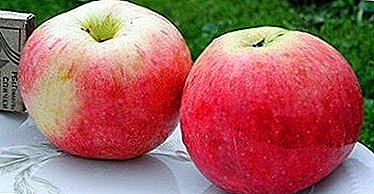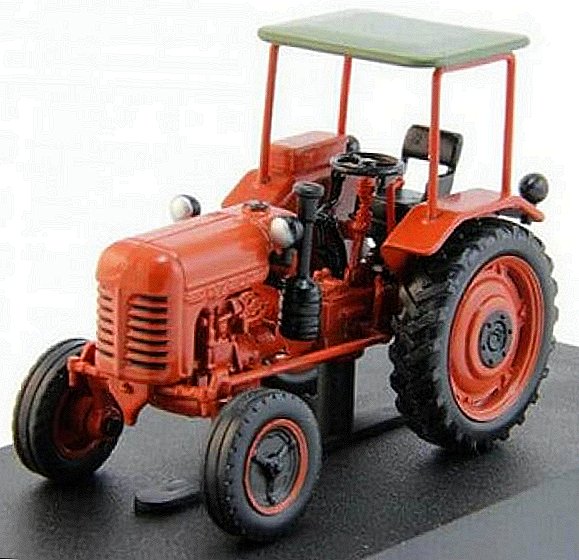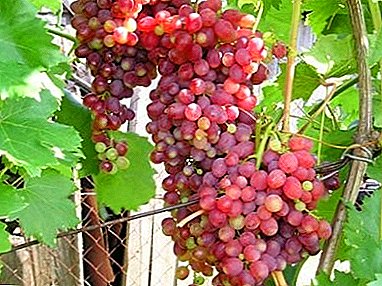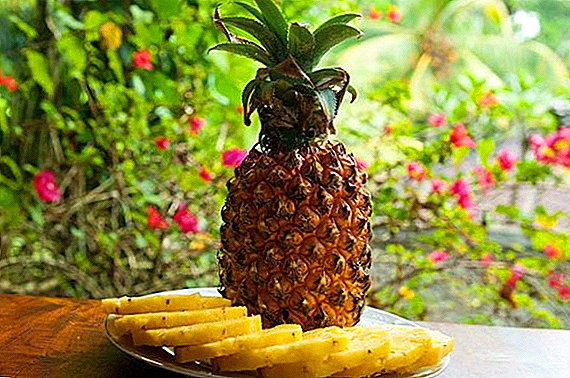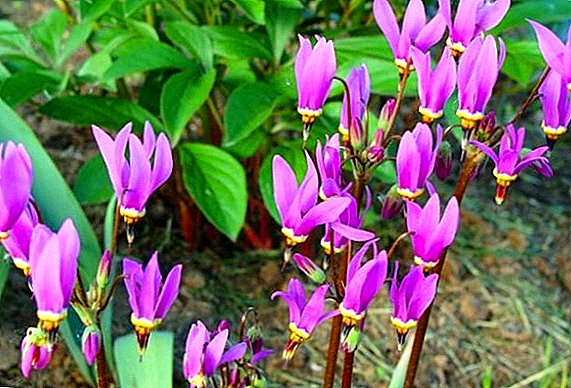 At the word "dodecateon" imagination draw a lush and exquisite flower. And if you say a woodbird, a goose-colored, a chandelier or a steppe, then at best some kind of grass appears. However, this is not the case. It is about the same plant, able to surprise not only with the name, but also with unpretentiousness, and beauty, and originality, and even with its healing properties.
At the word "dodecateon" imagination draw a lush and exquisite flower. And if you say a woodbird, a goose-colored, a chandelier or a steppe, then at best some kind of grass appears. However, this is not the case. It is about the same plant, able to surprise not only with the name, but also with unpretentiousness, and beauty, and originality, and even with its healing properties.
Description
The birthplace of the flower is North America, it has been known since ancient times. There are 15 species and 23 subspecies of this perennial plant. But in our climatic conditions only a few of them grow. And then - only on the sections of flower growers or in other cultural plantings.  Since in the homeland the dodecateon bloom is timed to the rainy season, it also has time for us to blossom to the beginning of summer. Grow prefers in wooded and mountainous areas, on the banks of rivers.
Since in the homeland the dodecateon bloom is timed to the rainy season, it also has time for us to blossom to the beginning of summer. Grow prefers in wooded and mountainous areas, on the banks of rivers.
It belongs to the primrose family. Outwardly very similar to cyclamen or miniature primula.
In total in the world there are about 500 species of primroses. They differ in the shape and color of leaves, flowering time. Many species are curative. Learn how to plant a primrose, as well as how to grow a primrose room.
Dodecateon has a strong rhizome with fine roots. The plant has an elegant basal rosette (its diameter is 20-30 cm) of wide and oval leaves, which taper towards the end of the leaves, the size of which reaches 30 cm. The color of the leaves is bright green.
The stems are straight, about 30 cm high. The flowers are small (3 cm), with heads down, petals bent up, located on the top of the stems, like a cap.
Their color is pink, white, lilac. As the flower opens, bright yellow anthers appear in the foreground. For this, in the USA it is also called the "meteor" - so it resembles a flying rocket.  By the beginning of the hot summer, he manages to bloom, the above-ground part - the leaves, stalks and flowers dry up, and the roots continue to live their own lives.
By the beginning of the hot summer, he manages to bloom, the above-ground part - the leaves, stalks and flowers dry up, and the roots continue to live their own lives.
Numerous seeds from the dried seed box (externally it looks like a barrel) are carried by the wind.
Did you know? The ancient Greeks called primrose dodecateon - the flower of the twelve gods - and considered it a magical potion to help heal all ailments.
Distinctive features
These properties dodekateona include such:
- resistance to temperature changes;
- unpretentiousness to the soil;
- endurance;
- frost resistance;
- decorative appearance;
- medicinal properties;
- melliferous qualities.
Types used in floriculture
Although all these varieties belong to the same family, but, like all relatives, they have both similarities and differences. Favorite species among gardeners include:
- dodecateon average - the most popular type of this flower. In natural conditions, it prefers to grow on rocky river banks or in a brightly lit sun. There are tall and undersized varieties, respectively, its height ranges from 20 to 50 cm. The leaves are light green, wide and oval, their length is up to 30 cm. Dazzling white, yellow or pink flowers are collected in umbrella inflorescences of 15-20 pieces per every Duration of flowering - 35 days;

- dodecateon cold - leaves are dark, egg-shaped, small. The number of flowers is also small - only 2-3 in the inflorescence. The color of flowers is from pink to pale lilac, the base of the petals is yellow, the anthers are purple;
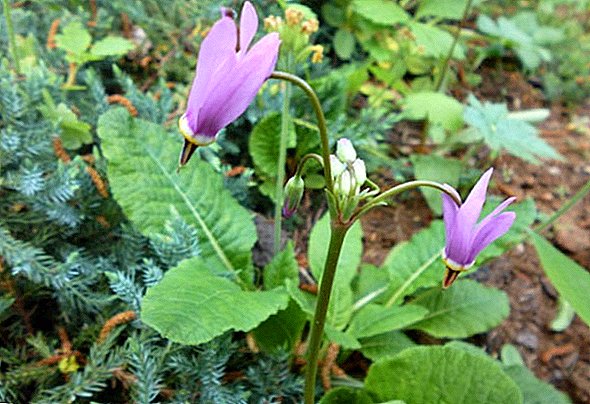
Important! During the initial withering of seedlings you should not use radical measures and remove the flower from the garden - its roots are alive and just increase the mass.
- large dodecateon (pretty) - blooms in pink or purple, the number of flowers in an umbrella inflorescence is from 5 to 8, the leaves are yellow-green with a wavy edge;

- Cleveland dodecateon - from one root grows to 15-16 stems, and the flower itself resembles a bush. Flowers gently pink or lilac with a white or yellow rim. There are a large number of varieties (at least 6) of this species.
 Among them stand out:
Among them stand out:"Hermit" - grows in the most inaccessible places;
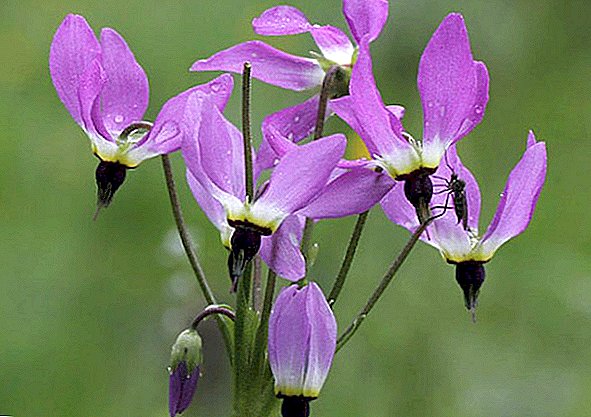 "Spreading" - the smallest representative of the species;
"Spreading" - the smallest representative of the species;  "Sacred" - the most hardy and cold-resistant;
"Sacred" - the most hardy and cold-resistant; 
- notched dodecateon - Another fan of dampness. Prefers to "live" in damp places, in forests, on the banks of rivers or other bodies of water. Radical leafy rosettes are very lush, the edges of the leaves have a zigzag appearance, which gave the name to this species. Another distinctive feature is low growth (about 20 cm in total). Flowers are white, yellow at the base. Anthers purple;

- dodecateon amethyst - the favorite of many gardeners for rich color of flowers;

- Henderson's dodecateon - it is distinguished by the height of peduncles, it reaches 50 cm. Due to this, the flowers rise favorably over other vegetation of this period and attract attention.

Breeding
Propagate this primrose in two ways.
Division
This should be done in the fall or early spring. The adult bush is dug out, its rhizome is divided into several parts. You should not make special efforts to divide the bush - usually it splits into several “branches”.
It is important that each has a growth bud - this is the future new bush of the plant. After 2 years it will be full primrose bushes.
Important! After 4-5 years, the bushes need to thin out, using this method to rejuvenate the flowers.
Out of seed
Seed propagation is a more complicated and time-consuming method. In spring, seeds are sown in open ground.
Shoots appear very soon, literally in two weeks, but also quickly fade. A week later there will be new shoots and leaflets. Flowers in the year of planting should not wait. They will appear in the 4-5th year.
Video: how to sow dodecateon
Planting flower
For planting this flower choose shady places, well it takes root in partial shade. If the dodecateon is still in a sunny place, you need to make sure that its roots do not overheat.
Soils - light, well-fertilized and hydrated (but without stagnant water). For fertilizer used chopped peat or rotted leaves.
Read more about different types of soil, fertilizer systems for them, and also learn how you can improve soil fertility.
The place where the landing is planned should be:
- fenced;
- cleared of weeds;
- loosened.
Delenki should be planted in pre-prepared landing pits in small groups of 5-7 pieces. The size of the pits should correspond to the size of the plant, the minimum distance between them is 10 cm.  Before planting, the hole should be watered, and after the plants are planted, the ground should be compacted near the stem and watered again. You can grumble humus.
Before planting, the hole should be watered, and after the plants are planted, the ground should be compacted near the stem and watered again. You can grumble humus.
Care features
Dodecateon is very unpretentious, perfectly tolerates both drought and frost. But even he needs some attention and care. The basic rules of care are reduced to three:
- moderate watering;
- weed removal;
- top dressing with fertilizers.
One of the most important points in garden care is weed removal. Learn more about the biological groups of weeds, as well as how to deal with them with folk remedies, special tools and herbicides.
With watering it is important not to overdo it, so that the roots of the flower do not start to rot. Organic and complex mineral fertilizers that can be applied once a month are suitable for feeding.
This primrose does not require special preparation for the winter. Without any shelters, he will spend the winter well. Young seedlings should be protected from slugs and moles.
Did you know? American lovers of stony gardens have chosen the flower of the dodecateon as the emblem of their society.
The dodecateon fills the floral pause in the transition from the first spring to the summer flowers.
With a skillful approach or a strong desire for freshness and bright colors after winter, you can build a wonderful alpine slide, make a small motley flowerbed, decorate the shore of an artificial reservoir, create rock arias with the help of this American guest.  Then the transition to the summer will be easy and colorful, and the dodecateon - the desired and favorite inhabitant of the estate.
Then the transition to the summer will be easy and colorful, and the dodecateon - the desired and favorite inhabitant of the estate.
Feedback from network users on the cultivation of dodecateon








 Among them stand out:
Among them stand out: "Spreading" - the smallest representative of the species;
"Spreading" - the smallest representative of the species;  "Sacred" - the most hardy and cold-resistant;
"Sacred" - the most hardy and cold-resistant; 



